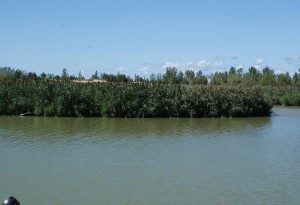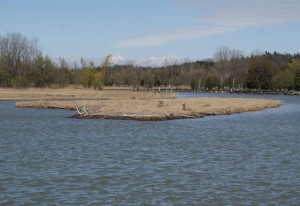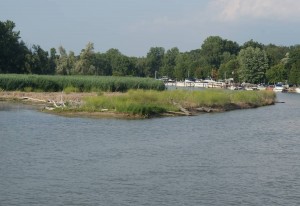Nancy Vidler tells us more about the Port Franks Community Phragmites Control Project.
What is the geographic scope of the project?
Approximately 33 hectares (80 acres) of Lake Huron coastal wetlands and dunes located within the community of Port Franks.
Type of project
- Direct management (i.e. spraying, burning)
Why is Phragmites an issue in your area?
Dense Phragmites cells have established throughout our community negatively impacting native plants and animals, blocking shoreline views, reducing property values and access for swimming, fishing and hunting. In addition it poses a potential fire hazard. This plant is significantly reducing wetland habitat for a number of species including Endangered, Threatened and Special Concern. The wetlands are recognized as Areas of Natural and Scientific Interest (ANSI).
What is your organization’s approach to invasive Phragmites management?
This is a collaborative effort of the Lambton Shores Phragmites Community Group and local agencies, the Municipality and landowners. The goal of this project is to substantially reduce the population of Phragmites in Port Franks. This is a three-phased project. Phase 1 included a well-attended community education meeting, the treatment of 2 demonstration sites in 2011, the inventory and mapping of Phragmites locations, planning meetings, one-on-one discussions with landowners, and obtaining their consent. Phase 2 involved on-the-ground actions to reduce Phragmites in accordance with the Ministry of Natural Resources Best Management Practices Manual. This entailed herbicide application, rolling and burning. Phase 3 will include reducing Phragmites in secondary priority areas, touch up treatment as needed in the primary areas and continued community outreach and education to ensure this invasive species is not re-introduced to our community.
Who are your partners in this effort?
We are partnering with The Lake Huron Centre for Coastal Conservation, Ausable Bayfield Conservation Authority, Nature Conservancy Canada, the Municipality of Lambton Shores, Rural Lambton Stewardship Network, and over 60 individual private landowners.
What are the funding sources?
The total project cash cost is estimated at about CDN$64,000 and we have received cash contributions from the Municipality of Lambton Shores, Ausable Bayfield Conservation Authority, Nature Conservancy Canada, local beach associations and private landowners. We also received a CDN$23,000 Great Lakes Community Fund grant. In addition, we received over CDN$40,000 of in-kind contributions, such as volunteer labor, project planning and technical support.
What are the goals and objectives for the project?
Our goals and objectives include: 1)strategic eradication of Phragmites in the Port Franks community, 2) educating and empowering our community, 3) protecting our water, 4) restoring habitats to protect vulnerable species and 5) ensuring long term protection from re-infestation.
What type of land does your project target?
Lake Huron shoreline (coastal dunes), coastal wetlands and river corridors.
Do you monitor the areas that you manage? If so, what does that entail?
We do. Success will be determined by: 1) the reduction of Phragmites, 2) by the re-population of infested lands with native plants, 3) increased community engagement, 4) the involvement of volunteers and 5) increasing the number of partnerships with other agencies and organizations. Measurement parameters include: hectares (acres) of patches and kilometres (miles) of shoreline with reduced or eliminated Phragmites, number of citizens participating in control program and observations of wildlife including Species At Risk within the restored habitats and throughout our community.
A Monitoring Template (in development) will be used by community based volunteers to record and report observations on a coordinated and systematic basis.
What is the status of the program and are you seeing results?
We are now in Phase 3 of the project, doing touch up work and developing observation tools. Visually, in the areas we have treated, a significant reduction of Phragmites has occurred and native plants and grasses and wildlife are re-appearing. Where Phragmites has re-appeared, the density of plants per square meter is substantially reduced. Recreational activities have noticeably increased.
Can you share information about challenges and lessons learned (both about what worked and what did not work)?
Restrictions regarding herbicide use:
• Presently in Canada there are no safe herbicides legally available to control Phragmites in or near water nor the option to apply aerially where appropriate
• Funding opportunities are extremely limited and many grants will not support the use of herbicides for Phragmites control
• Public awareness about the Phragmites threat and required control methods using herbicides is not at the level it should be
• If the Phragmites control initiatives were not undertaken by the local Conservation Authority a Letter of Opinion had to be obtained and the lack timely approval for this permit greatly hampered control efforts
Securing Permits from the Ministry of Natural Resources (MNR) created our first challenge.
• We have applied for a Letter of Opinion (exemption from the Pesticide Act) on 2 occasions. The first application was delayed at the MNR office and we missed the opportunity to begin the restoration and had to wait another year which resulted in the Phragmites gaining a stronger foothold and costing more.
• The second permit (applied for 6 months previous to the work) was obtained at the last minute only because we asked for the support of our local Member of Parliament.
• We also learned that we needed to request a longer period of time in our applications to allow for touch up (5 years is recommended).
• There must be more of an understanding by the MNR of the narrow window to treat the plant. Engaging our local MPP has helped.
• A solution to this could be partnering with your local Conservation Authority as acting for the MNR, they can oversee the work.
• Each Municipality has specific fire permit regulations and in our area a permit to conduct a controlled Phragmites burn was only valid for 2 weeks. This window was not sufficient to allow for weather, fire specialist crew availability, and wildlife considerations. Therefore numerous permit applications had to be submitted. A solution to this would be to negotiate for a longer permit.
Education is very important throughout all phases of the project. Some examples of things that worked for us are:
• Having representatives from our Community Group on site when work was being done to answer questions and provide information.
• Hosting Community Information Sessions (partnering with Conservation Authority/Municipality)
• With the support of the Municipality, sending out a newsletter with tax notices which provided general information, suggested what property owners could do to prevent Phragmites from spreading and provided contact information.
• We also provided progress reports to the community at various stages of the work.
• The demonstration project provided a visual reference for residents.
• We also offered to do presentations for community organizations: Rotary International, Probus, Garden Clubs, Beach Associations, Carolinian Canada Workshop for Landowners etc.
• We engaged local media and our government representatives by organizing on- site visits.
• We organized a training opportunity for municipal, county and conservation authority front line staff as well as local contractors.
• We are currently working on information signage to be posted throughout the community
• We are also considering developing a Phragmites Control Program newsletter
• We have noticed through this Project that the community is now more active and engaged in stewardship and protection of our natural heritage and there appears to be an increase in community spirit
• We have also provided a model for other communities to follow and residents have been very active in sharing our knowledge and experience
The lack of funding for projects such as ours has presented a huge challenge. Even though recognized as an Area of Natural and Scientific Interest, no money was available through the Provincial Ministry of Natural Resources or the Federal Government. The Municipality, Conservation Authority, Nature Conservancy Canada and landowners did contribute but had we not received assistance through the Great Lake Community Guardian Fund (GLCG) we would not have been successful in this project. We were granted GLCG funds because we had completed the herbicide application and were not requesting money for this component of the restoration. The fact that grants will often not support the use of herbicides continues to present a challenge. One idea that we are pursuing is to apply for research grants.
We need to enable landowners to deal with Phragmites on their property. At this time, the plant is not listed as a noxious weed and therefore it continues to spread.
For more information please contact:
Nancy Vidler
10039 Wedd Rd.
Port Franks, Ontario N0M 2L0
Canada
(519)243-2562
nancyv@execulink.com



